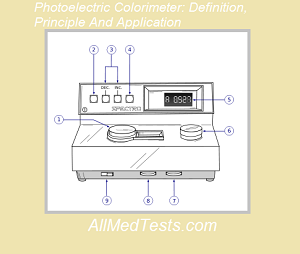The field of chemistry is full of devices that are used for different tests and measurements. Operating these devices take some good technique and learning. Colorimeter is one of those devices in the field of chemistry. The light waves of various wavelengths can be absorbed different solutions. However, before this device, we didn’t know exactly how to calculate that. Now, with the Photoelectric Colorimeter, we can easily measure the ability of any solution to absorb the light waves of various wavelengths. This device has helped scientists in a lot of ways. Many scientific experiments have been made easy with the help of this device. Today, we are going to talk about the Working Principle, how to use this device and much other information on this device. Read more about the Photoelectric Colorimeter down below and increase your knowledge on this beautiful device used in the field of chemistry.

Photoelectric Colorimeter Definition:
Photoelectric colorimeter is a device that is used for the quantitative analysis of different substances like glucose, blood urea, blood enzymes etc. It works on the principle of absorption of light which is explained in detail below.
Photoelectric Colorimeter Working Principle:
Most of the students learning advanced sciences know about the Beer-Lambert’s Law. According to this law, the medium concentration of any liquid is directly related to the waves absorbed in the liquid when waves are passed through it. This device is based on the same principle and you will need be understanding in order to get it. You can only perform and understand this experiment well if you know about Beer Lambert’s Law. Let us now have a look at how the experimentation works in this device.
How to use Photoelectric Colorimeter?
Here is an easy step by step guide to show you how this device works. There is nothing complex in the principle and working of the colorimeter. However, if you are not familiar with the Beer-Lambert’s Law, then you must read it first. The working of this device is based on it and you can do better if you understand the experiment. Let us tell you with a step by step guide to teach you how to use Photoelectric Colorimeter.
- The whole operation is carried out with the help of few lenses, colorimeter, and a light source. There are measurement recorders in the colorimeter as well.
- First, you pass the light waves through the fluid. Make sure with the help of lenses that these waves reach the measuring device.
- Once these waves who have the same wavelengths pass through the measuring meter, a reading is recorded.
- Different readings are taken by repeating the same process.
- Then the readings are compared to see the final results of the ability of the fluid to absorb these light waves.
And, this is how you easily perform this experiment with the help of Photoelectric Colorimeter.
Photoelectric Colorimeter Applications:
· This device can be used to do a number of things. First, this device can be used to measure the growth rate of yeast or bacterial material. The device is known for its higher accuracy to do the thing. Also, in the bird’s plumage, you can find the assessment of colors with the help of this device.
· And this is not all. Photoelectric Colorimeter is not just used for the lab purposes in the field of chemistry. The quality of water can also be measured with the help of this device. Different chemicals and their qualities are tested simply by using this amazing measuring device.
What else do you want from a single instrument which already performs so many operations?
Final Words from Photoelectric Colorimeter Working Principle and Use:
So this was all from the Photoelectric Colorimeter Working Principle and Use. If you liked this article then don’t forget to leave us your feedback about the article. Also, let us know the name of experiments you want to learn so we can do them too. Keep visiting All Med Tests for more scientific tests, devices, and experiments.






Leave a Reply